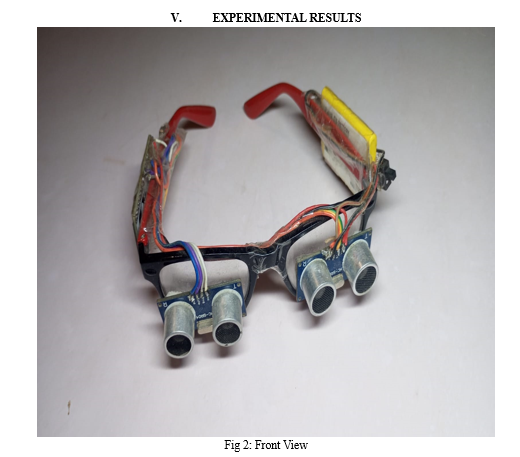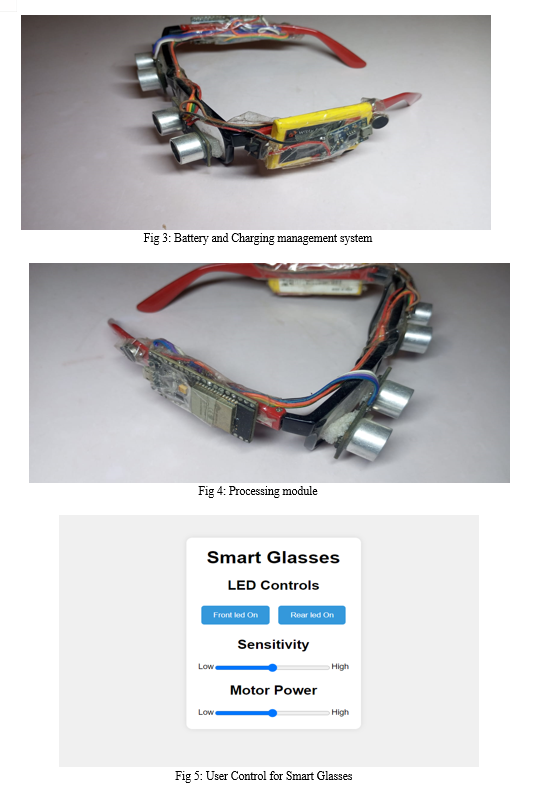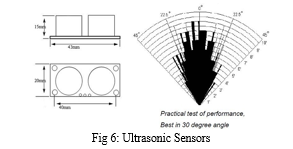Ijraset Journal For Research in Applied Science and Engineering Technology
- Home / Ijraset
- On This Page
- Abstract
- Introduction
- Conclusion
- References
- Copyright
Obstacle Avoidance Using Wi-Fi Enabled Smart Ultrasonic Glasses for Visually Blind
Authors: Mohammad Arshad Ahmed, Dr. G. Venkatarami Reddy
DOI Link: https://doi.org/10.22214/ijraset.2023.55910
Certificate: View Certificate
Abstract
Despite the fact that vision is a fundamental sense that has a significant impact on our daily lives, millions of people struggle with blindness. The Ultrasonic Smart Glasses for the Blind have been developed in response to this critical need, offering a ground-breaking solution that fuses cutting-edge technology with useful design. A pair of glasses, an obstacle detection module, a Wi-Fi-capable processor, a vibrating component for feedback, and a dependable power source are all combined in this ingenious device. The ultrasonic module, which has two ultrasonic sensors, is the brain of this system. A microcontroller-controlled processing unit uses intelligent interpretation of sensor data to provide real-time obstacle information. These lightweight, affordable smart glasses have the potential to significantly improve the mobility and safety of people with visual impairments by providing them with a variety of beneficial capabilities. Offering them newfound independence by aiding in obstacle avoidance and navigation.
Introduction
I. INTRODUCTION
A Vision is one of the most important senses of the human body, providing us with the ability to perceive the world around us using our eyes. Our eyes have complex organs that work to capture, process and transmit information to the brain, allowing us to see, distinguish colors, shapes and movement. The human eye is an incredibly complex and intricate organ that plays a vital role in our daily lives. The ability to see is something that many of us take for granted, but it is an essential part of our existence. Our vision allows us to appreciate the world around us, communicate with others, and perform countless daily activities that we rely on. Without our eyesight, many of the things that we consider to be normal would be impossible. It is therefore crucial to understand the importance of maintaining healthy vision and to take steps to protect it. In today's world, vision loss is a prevalent problem, affecting millions of people globally. It can severely limit a person's ability to perform daily activities, which can be frustrating and demotivating. However, with the advancement of technology, medical devices are now available to assist people with visual impairment, helping them to live a more independent and fulfilling life. One such device is a Smart ultrasonic Glasses, designed to help them navigate their surroundings, detect obstacles, and avoid collision, this device helps the blind to sense the environment hand-free and provides a independent life.
Millions of people who struggle with blindness aspire for the freedom to lead independent lives in a society where the ability to see is a window to independence. The Ultrasonic Smart Glasses for the Blind stand out as a light of hope in this world of unmet demands. These innovative tools provide a lifeline to those with visual impairments and open doors to a renewed sense of autonomy and independence. These smart glasses promise to improve the lives of the blind by seamlessly merging a pair of spectacles with an advanced obstacle detection module, a Wi-Fi capable processing unit, tactile feedback mechanisms, and a reliable power source. a design and functionality innovator. These glasses are poised to redefine the boundaries of what's possible, offering a lifeline for those who have long navigated the world with limited sight.
II. LITERATURE SURVEY
A. “Smart Glass for visually impaired persons”
This device has a buzzer component, a processing unit, a pair of glasses with an obstacle detection module built into them in the center, a power source, and an output device. The processing unit is coupled to the output device and the obstacle detecting module. The central processing unit is powered by the power supply. The obstacle detection module's main components are an ultrasonic sensor, a control module for processing, and a buzzer for output. The control unit operates the ultrasonic sensors, gathers data about the barrier in front of the person, processes the data, and then outputs the appropriate output through the buzzer. The main drawback is this design is limited to a single ultrasonic module where the range is limited.
B. “Low-cost ultrasonic glasses for blind”
This paper is a different approach where a pair of glasses with an obstacle detecting module mounted in the middle, a processing unit, an output device, such as a beeping component, and a power supply are all included in this gadget. The processing unit is coupled to the output device and the obstacle detecting module. The central processing unit is powered by the power supply. The ultrasonic sensor, control module, and buzzer that make up the obstacle detection module's processing and output units are its basic components. The control unit operates the ultrasonic sensors, gathers data about the barrier in front of the person, processes the data, and then outputs the appropriate output through the buzzer. These Ultrasonic Smart Glasses for Blind people is a portable device, easy to use, light weight, user friendly and cheap in price yet functional by the disabled person. These glasses could easily help the blind people to sense and help them avoid obstacles.
C. “Smart Glass for Blind people”
Blind mobility is one of the major challenges encountered by visually impaired people in their daily lives. Their life and activities are greatly restricted by loss of eyesight thus limiting the normal life. They normally travel using blind navigation system or by their accumulated memories in their long-term exploration. The main objective of the creator was to present work is develop a low cost, reliable, portable, user friendly, low power and robust solution for smooth navigation indoor as well as outdoor. This paper (Smart Glasses for Blind People), as meant are the glasses are for visually impaired people who cannot see. It has an in-built sensor in it which spreads ultrasonic waves in the direction the person is going by scanning at most 5-6 meters of 30ºrange. As soon as the obstacle is detected, the sensor detects it and sends it to the device which generates an automated voice in the earphone connected to the person's ear. An automated voice can be an hazard as it can distract the person from its environment.
III. METHODOLOGY
A white cane is a long, slender cane used by people who are blind or visually impaired to assist them in navigating their surroundings. It is an essential tool for many individuals with visual impairment and has been in use for over 100 years. The white cane helps blind or visually impaired individuals detect obstacles and identify changes in the terrain, such as steps, curbs, and uneven surfaces. It also provides a means of communication, signaling to others that the person carrying the cane has a visual impairment and may require assistance.
A. Drawbacks
- Limited Range: White canes are most effective in detecting obstacles that are in proximity. They may not be as effective in detecting obstacles that are beyond the user's reach, which can limit the user's mobility and independence.
- Lack of Detail: While white canes can detect obstacles, they do not provide a lot of detail about the objects in the user's environment. This can make it difficult for users to get a complete picture of their surroundings.
- Social Stigma: Using a white cane can sometimes lead to negative stereotypes or discrimination from others who may assume that the user is helpless or dependent.
There Smart ultrasonic glasses offer several advantages for the blind, including improved mobility, safety, and independence. One key advantage is that the glasses can provide real-time feedback on the user's surroundings, allowing them to navigate safely and confidently. By using ultrasonic sensors to detect obstacles and distance, the glasses can alert the user to potential hazards, such as steps or obstacles in their path, and provide audio or haptic feedback to help them avoid them smart ultrasonic glasses can help to reduce the social stigma associated with traditional mobility aids, such as canes or guide dogs, and may encourage more visually impaired individuals to venture out and explore their surroundings. The glasses can also be customized to the user's preferences and needs, such as adjusting the sensitivity of the sensors or providing audio feedback in different languages.
B. Benefits
- Improved safety: Smart ultrasonic glasses can help blind individuals avoid obstacles and hazards in their path, reducing the risk of accidents and injuries.
- To Increased independence: The use of smart ultrasonic glasses can increase the independence of visually impaired individuals by providing them with real-time information about their surroundings. They can navigate through unfamiliar environments with more ease and safety.
- Convenience: With the use of smart ultrasonic glasses, blind individuals don't have to rely on guide dogs, canes or other external aids, making their daily life more convenient.
- Real-time feedback: The glasses provide real-time feedback about the distance of objects, allowing individuals to make informed decisions about how to move around their environment.
- User-friendly: Smart ultrasonic glasses are easy to use and can be customized to the individual's needs and preferences, making them a user-friendly device.

C. Modules
The modules being implemented are:
- Object Detection Module: It has been programmed to detect any obstacle in its path to overcome the range issue, Resembling the human eye.
- Processing Module: It is used to process the information from the object detection modules process it and send it over to the haptic feedback modules which can be controlled over Wi-Fi and Bluetooth
- Feedback module: It provides the capability to notify the user without disturbing the normal functioning senses.
IV. IMPLEMENTATION
A. Obstacle detection
The ultrasonic sensor works by emitting a high frequency sound wave, typically at 40,000. Hz, which travels through the air. If there is an obstacle or object in its path, the sound. wave will bounce back to the sensor module. By measuring the travel time of the sound wave and knowing the speed of sound in air, the distance to the object can be calculated. To generate the ultrasound, the Trig pin is set to a high state for a brief period typically, 10 μs. This sends out an 8-cycle ultrasonic burst which travels at the speed of sound. The Echo pin is then activated and starts listening for the reflected pulse from an object. If no object is detected, the Echo pin will time-out after 38ms and return to a low state. If a reflected pulse is received, the Echo pin will go low sooner than the 38ms time-out period. By measuring the duration, the Echo pin was high, the distance the sound wave traveled can be calculated using the formula Distance = Speed x Time / 2, where the speed of sound is 340m/s.
B. Proposed Algorithm
- To implement the Ultrasonic Smart Glasses for Blind, the following libraries must be installed and imported: HCSR04 for ultrasonic sensor functionality, AsyncTCP for asynchronous network communication, Async Webserver for web interface interaction, and the time library for time-related operations.
- There are 3 phases in obstacle detection.
a. Obstacle Detection: It sends an ultrasonic pulse out at 40kHz which travels through the air and if there is an obstacle or object, it will bounce back to the sensor. By calculating the travel time and the speed of sound, the distance can be calculated.
b. Processing This phase involves evaluating the distance data obtained in the previous step against user-defined configuration settings, specifically the threshold value. When the calculated distance to an obstacle falls below the threshold value, the haptic feedback module is activated.
c. Haptic feedbacks: The haptic feedback module offers a non-invasive means of alerting the user, employing vibrations whose magnitude corresponds to the proximity of obstacles on both sides of the user.
3. The ultrasonic sensors constitute the cornerstone of the smart glasses, serving as dynamic environmental sensors. Upon device activation, the glasses establish a connection to a Wi-Fi network and load a user-friendly landing page accessible through a web browser.
4. After initial setup, sensitivity levels and haptic feedback controls can be configured by the user via sliders, as depicted in Figure 6. Subsequently, the smart glasses are powered on.
5. With the device in operation, users can comfortably wear smart glasses throughout their daily routines. Additionally, the glasses feature front and back LEDs that can be activated during nighttime hours, enhancing user visibility and alerting the surrounding environment to the user's movements.



VI. FUTURE WORK
- Smart Glasses can be enhanced to a more accuracy level targeting to 100%.by using ladar or Radio frequency.
- Si-Graphene lipo can be used to decrease weight, this would be a good addition as lipo is the heaviest unit.
- Argument reality such as oculus rift and computer vision can be used with combination of large language model such as multimodal to analyze the environment locally.
Conclusion
The development of smart ultrasonic glasses for blind individuals provides a solution to many of the challenges they face in their daily lives. These glasses offer a range of advantages, including increased independence, improved safety, convenience, real-time feedback, user-friendliness, improved social interactions, and integration with other technologies. By providing visually impaired individuals with real-time information about their surroundings, these glasses can help them navigate through unfamiliar environments with more ease and safety. Overall, the development of smart ultrasonic glasses is an important step towards improving the quality of life and independence of blind individuals and has the potential to revolutionize.
References
[1] Smart Dr. Lavanya Dhanesh, B. Surya Prakash, P. Sai Dinesh, S. Kavi Kumar, and K. Nivin, “Smart Glass for Visually Impaired Persons ” [2] R. Agarwal et al., \"Low cost ultrasonic smart glasses for blind,\" 2017 8th IEEE Annual Information Technology, Electronics and Mobile Communication Conference (IEMCON), Vancouver, BC, Canada, 2017, pp. 210-213, doi: 10.1109/IEMCON.2017.8117194. [3] ASM Iftekhar Anam, Sahinur Alam and Md Yeasin, \"A dyadic conversation aid using google glass for people who are blind or visually impaired\", Mobile Computing Applications and Services(MobiCASE)6th International Conference, 2015. [4] “Yocto project,” https://www.yoctoproject.org/ [5] Feng Lan, Guangtao Zhai and Wei Lin, \"Lightweight smart glass system with audio aid for visually impaired people\", TENCON IEEE Region 10 Conference, 2015.
Copyright
Copyright © 2023 Mohammad Arshad Ahmed, Dr. G. Venkatarami Reddy. This is an open access article distributed under the Creative Commons Attribution License, which permits unrestricted use, distribution, and reproduction in any medium, provided the original work is properly cited.

Download Paper
Paper Id : IJRASET55910
Publish Date : 2023-09-27
ISSN : 2321-9653
Publisher Name : IJRASET
DOI Link : Click Here
 Submit Paper Online
Submit Paper Online

